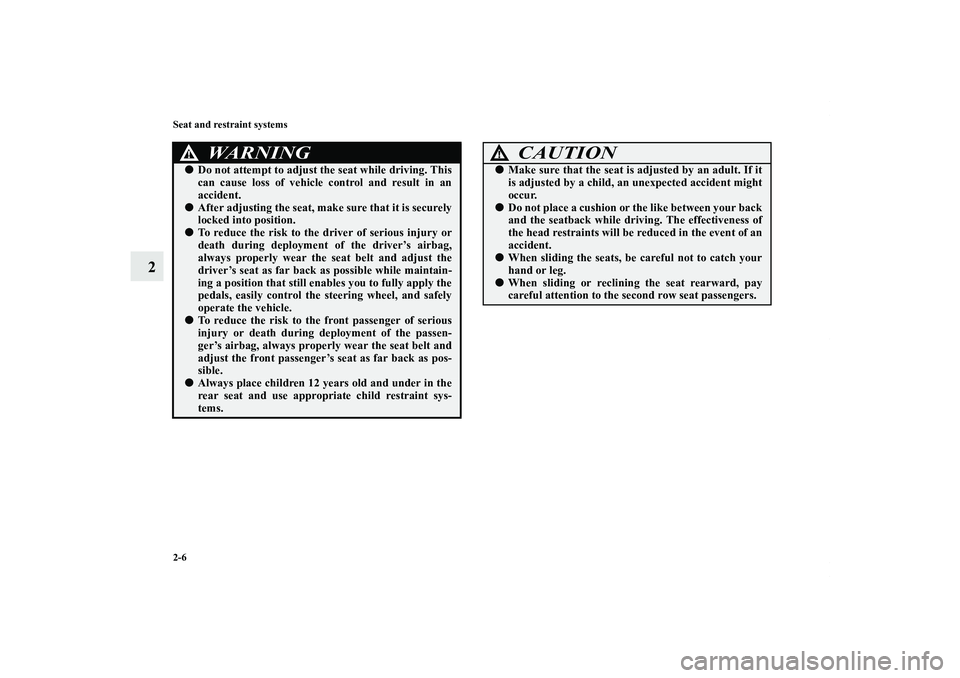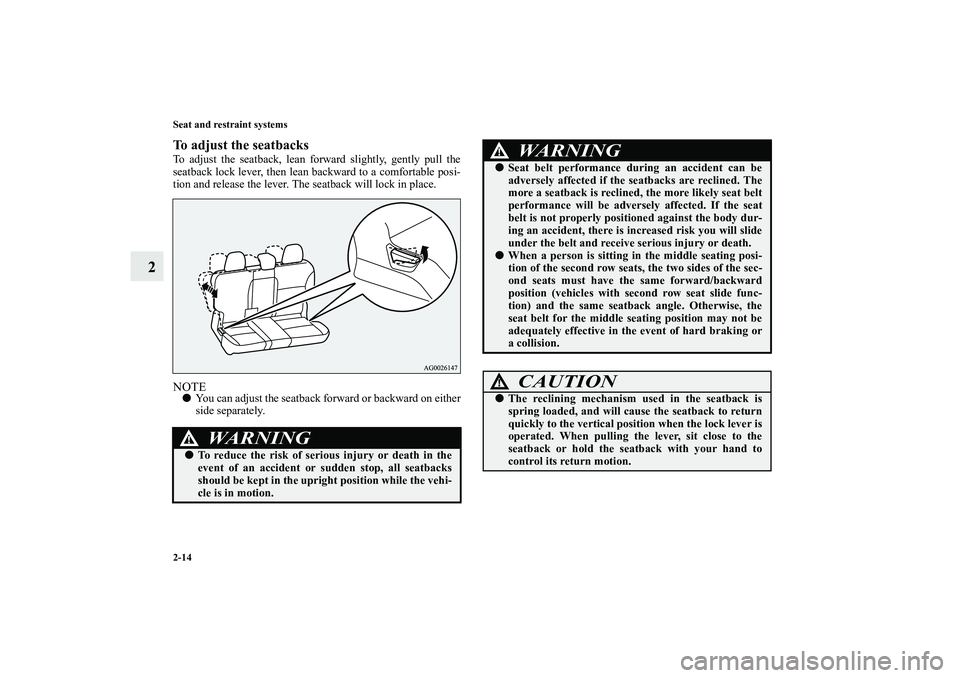Page 32 of 714

Seat and restraint systems
2-5
2 Seats and restraint systems
N00401600153
Your vehicle has seat belts and other features that help protect
you and your passengers in an accident.
Seat belts are the most important safety device. When worn
properly, seat belts can reduce the chance of serious injury or
death in various types of crashes. For added protection during a
severe frontal collision, your vehicle has a Supplemental
Restraint System (SRS) with airbags for the driver and passen-
gers. The seats, head restraints, and door locks also are safety
equipment, which must be used correctly.
Always check the following before you drive:
�That everyone in your vehicle is properly wearing their
seat belt.
�That infants and small children are properly secured in
appropriate child restraint systems in the rear seat.
�That all doors are fully closed and locked.
�That seatbacks are upright, with head restraints properly
adjusted.
Safety equipment cannot prevent injury or death in all motor
vehicle accidents. You can help reduce the risk of injury or
death, however, by following the instructions in this manual.
Front seats
N00401800331
Position the driver’s seat as far back as possible while main-
taining a position that still enables you to fully apply the ped-
als, easily control the steering wheel and safely operate the
vehicle.
Power seat adjustment Manual seat adjustment
BK0138000US.book 5 ページ 2011年4月13日 水曜日 午前11時17分
Page 33 of 714

2-6 Seat and restraint systems
2
WA R N I N G
!�Do not attempt to adjust the seat while driving. This
can cause loss of vehicle control and result in an
accident.�After adjusting the seat, make sure that it is securely
locked into position.�To reduce the risk to the driver of serious injury or
death during deployment of the driver’s airbag,
always properly wear the seat belt and adjust the
driver’s seat as far back as possible while maintain-
ing a position that still enables you to fully apply the
pedals, easily control the steering wheel, and safely
operate the vehicle.�To reduce the risk to the front passenger of serious
injury or death during deployment of the passen-
ger’s airbag, always properly wear the seat belt and
adjust the front passenger’s seat as far back as pos-
sible.�Always place children 12 years old and under in the
rear seat and use appropriate child restraint sys-
tems.
CAUTION
!�Make sure that the seat is adjusted by an adult. If it
is adjusted by a child, an unexpected accident might
occur.�Do not place a cushion or the like between your back
and the seatback while driving. The effectiveness of
the head restraints will be reduced in the event of an
accident.�When sliding the seats, be careful not to catch your
hand or leg.�When sliding or reclining the seat rearward, pay
careful attention to the second row seat passengers.
BK0138000US.book 6 ページ 2011年4月13日 水曜日 午前11時17分
Page 34 of 714
Seat and restraint systems
2-7
2
To adjust the seat forward or backward
N00401900228
Manual seat adjustmentPull the seat adjusting lever up and slide the seat forward or
backward to the desired position. Release the adjusting lever to
lock the seat in place.
Power seat adjustmentOperate the switch forward or backward to move the seat to the
desired position. Release the switch to lock the seat in place.NOTE�To prevent the battery from going dead, operate the power
seat with the engine running.
WA R N I N G
!�To make sure that the seat is securely locked, try to
move it forward or backward without using the
adjusting lever.
1- Forward (toward the front of the vehicle)
2- Backward (toward the rear of the vehicle)
BK0138000US.book 7 ページ 2011年4月13日 水曜日 午前11時17分
Page 35 of 714
2-8 Seat and restraint systems
2
To adjust the seatbacks
N00402000268
Manual seat adjustmentTo adjust the seatback, lean forward slightly, gently pull the
seatback lock lever up, then lean backward to a comfortable
position and release the lever. The seatback will lock in place.
Power seat adjustmentOperate the switch in the direction of the arrows to adjust the
seatback.NOTE�To prevent the battery from going dead, operate the power
seat with the engine running.
CAUTION
!�The reclining mechanism used in the seatback is
spring loaded, and will cause the seatback to return
quickly to the vertical position when the lock lever is
operated. When pulling the lever, sit close to the
seatback or hold the seatback with your hand to
control its return motion.
1- Move forward
2- Move backward
BK0138000US.book 8 ページ 2011年4月13日 水曜日 午前11時17分
Page 40 of 714
Seat and restraint systems
2-13
2 Second row seats (60/40 split fold/tumble
seats)
N00402500205
When sitting in the second row seat, adjust the head restraints
to heights at which they lock in position. Refer to “Head
restraints” on page 2-26. To adjust the seat forward or backward (vehicles
with second row seat slide function)Pull the seat adjusting lever and gently rock the seat forward or
backward to the desired position. Release the adjusting lever to
lock the seat in place.NOTE�You can adjust the seat forward or backward on either side
separately.
WA R N I N G
!�To make sure that the seat is securely locked, try to
move it forward or backward without using the
adjusting lever.
CAUTION
!�When sliding (vehicles with second row seat slide
function) or reclining the seat rearward, pay careful
attention to the third row seat passengers.
BK0138000US.book 13 ページ 2011年4月13日 水曜日 午前11時17分
Page 41 of 714

2-14 Seat and restraint systems
2
To adjust the seatbacksTo adjust the seatback, lean forward slightly, gently pull the
seatback lock lever, then lean backward to a comfortable posi-
tion and release the lever. The seatback will lock in place.NOTE�You can adjust the seatback forward or backward on either
side separately.
WA R N I N G
!�To reduce the risk of serious injury or death in the
event of an accident or sudden stop, all seatbacks
should be kept in the upright position while the vehi-
cle is in motion.
�Seat belt performance during an accident can be
adversely affected if the seatbacks are reclined. The
more a seatback is reclined, the more likely seat belt
performance will be adversely affected. If the seat
belt is not properly positioned against the body dur-
ing an accident, there is increased risk you will slide
under the belt and receive serious injury or death.�When a person is sitting in the middle seating posi-
tion of the second row seats, the two sides of the sec-
ond seats must have the same forward/backward
position (vehicles with second row seat slide func-
tion) and the same seatback angle. Otherwise, the
seat belt for the middle seating position may not be
adequately effective in the event of hard braking or
a collision.
CAUTION
!�The reclining mechanism used in the seatback is
spring loaded, and will cause the seatback to return
quickly to the vertical position when the lock lever is
operated. When pulling the lever, sit close to the
seatback or hold the seatback with your hand to
control its return motion.
WA R N I N G
!
BK0138000US.book 14 ページ 2011年4月13日 水曜日 午前11時17分
Page 43 of 714

2-16 Seat and restraint systems
2Third row seat (Seating 7 passengers)
N00419500063
The third row seat can be used for two additional passengers.
When the third row seat is not in use, it can be stowed under
the floor to provide more cargo area.
WA R N I N G
!�The third row seats are intended for use by no more
than two belted occupants, each of which does not
exceed 160 cm (63 inches) in height.
Exceeding these limitations can result in an
increased risk of personal injury or death in the
event of an accident.�The third row seats are not intended for use by
infants and small children who must use rear facing
or forward facing child safety seats.�Third row seat operation should always be made
before driving. Operating the seat while driving
could cause the seat to move more than necessary
and result in a serious injury or death.�Before using, check that the third row seat is firmly
secured. If not secured, the third row seat could
move and cause a serious injury or death in an acci-
dent.�The third row seat should not be used when the sec-
ond row seats are folded forward. Third row seat
passengers can suffer a serious or fatal injury if the
second row seats fell backward in a collision or when
heavy breaking is applied.
�When using the third row seat, always position and
lock the head restraints on top of the seat back.
See the steps 6 and 7 of the procedure for folding out
the third seat.�For vehicles equipped with the cargo area cover,
when the third row seat is in use, always remove the
cargo area cover to avoid serious injury or death in
the event of an accident.
Refer to “Cargo area cover”, page 3-287.
CAUTION
!�The third row seat should be adjusted only by an
adult. If it is adjusted by a child, an unexpected acci-
dent might occur.�When adjusting the third row seat, keep your hands
and feet away from moving parts and the space
below the seat.�Be careful not to touch the exhaust pipe, because it
will remain hot for some time after the engine is
stopped.
WA R N I N G
!
BK0138000US.book 16 ページ 2011年4月13日 水曜日 午前11時17分
Page 45 of 714
2-18 Seat and restraint systems
2
4. Pull the strap (C-black) to release the lock. 5. Tilt the third row seat assembly backward.
NOTE�If the third row seat is locked to the floor after tilting the
third row seat assembly backward, pull the strap (C-black)
again to release the lock.
BK0138000US.book 18 ページ 2011年4月13日 水曜日 午前11時17分